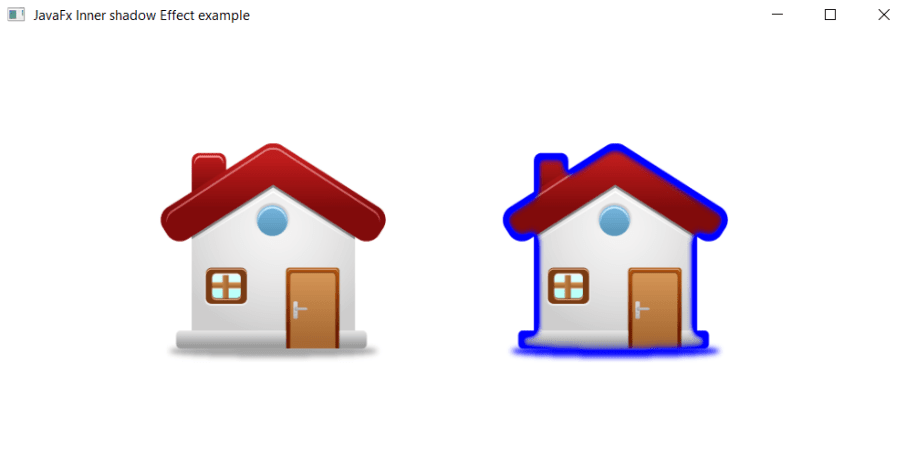JavaFX Inner Shadow
In the JavaFX application, in order to apply various Inner Shadow effect, we use this class. It has the ability to create the inner shadow of the given object. This effect is some what similar to shadow effect but only difference is it creates the shadow inside the edges of the node. All methods needed for this purpose are present in the javafx.scene.effect.InnerShadow class.
Properties and corresponding methods to create Inner Shadow Effect :
1. height
This property is of double type. It is used to represent the vertical size of the shadow blur kernel and the setHeight( Double value ) method is used to set it.
2. width
This is double type property. It is used to represent the horizontal size of the shadow blur kernel and the setWidth( Double value ) method is used to set it.
3. input
This property is of effect type. It is used to represent the input for the effect and the setInput( Effect value ) method is used to set it.
4. radius
This is double type property. It is used to represent the radius of the shadow effect and the setRadius( Double value ) method is used to set it.
5. choke
This is double type property. It is used to represent the choke parameter of the shadow effect and the setChoke( Double value ) method is used to set it.
6. blurType
This property is of blur type. It is used to represent the algorithm used for blur the shadow and the setBlurType( BlurType value ) method is used to set it.
7. offsetX
This is double type property. It is used to represent the x coordinate of the shadow and the setOffsetX( Double value ) method is used to set it.
8. offsetY
This is double type property. It is used to represent the y coordinate of the shadow and the setOffsetY( Double value ) method is used to set it.
Constructors to create Inner Shadow Effect :
- public InnerShadow() :
This constructor is used to create the new empty constructor with the default parameters.
- public InnerShadow(double radiusValue, Color colorvalue) :
This constructor is used to create the new constructor with the specified radius and color parameters.
- public InnerShadow(double radiusValue, double offsetX, double offsetY, Color colorvalue) :
This constructor is used to create the new constructor with the specified radius, offset x and offset y and color parameters.
- public InnerShadow(BlurType blurtype, Color colorvalue, double radiusValue, double choke, double offsetX, double offsetY) :
This constructor is used to create the new constructor with the specified radius, blur type, choke, offset x and offset y and color parameters.
JavaFX Effect – Image with and without Inner Shadow Effect :
Example:
import javafx.application.Application;
import javafx.scene.Group;
import javafx.scene.Scene;
import javafx.scene.effect.BlurType;
import javafx.scene.effect.InnerShadow;
import javafx.scene.image.Image;
import javafx.scene.image.ImageView;
import javafx.scene.paint.Color;
import javafx.stage.Stage;
public class EffectUI extends Application {
@Override
public void start(Stage stage) throws Exception
{
Image newimage = new Image("https://icons.iconarchive.com/icons/custom-icon-design/pretty-office-4/256/home-icon.png");
ImageView newimageView = new ImageView(newimage);
Image newimage2 = new Image("https://icons.iconarchive.com/icons/custom-icon-design/pretty-office-4/256/home-icon.png");
ImageView newimageView2 = new ImageView(newimage);
newimageView.setX(140);
newimageView.setY(90);
newimageView2.setX(440);
newimageView2.setY(90);
newimageView.setFitHeight(200);
newimageView.setFitWidth(400);
newimageView2.setFitHeight(200);
newimageView2.setFitWidth(400);
newimageView.setPreserveRatio(true);
newimageView2.setPreserveRatio(true);
InnerShadow shadow = new InnerShadow();
shadow.setBlurType(BlurType.GAUSSIAN);
shadow.setColor(Color.BLUE);
shadow.setHeight(25);
shadow.setRadius(12);
shadow.setWidth(20);
shadow.setChoke(0.9);
newimageView2.setEffect(shadow);
Group root = new Group(newimageView,newimageView2);
Scene scene = new Scene(root,800,400);
stage.setScene(scene);
stage.setTitle(" JavaFx Inner shadow Effect example ");
stage.show();
}
public static void main(String[] args) {
launch(args);
}
}
Output:
In order to create image with and without Inner Shadow Effect in JavaFX, we have to import all the required libraries such as javafx.application.Application, javafx.scene.Group, javafx.scene.Scene, javafx.scene.effect.InnerShadow, javafx.scene.paint.Color, javafx.scene.effect.BlurType, javafx.scene.image.Image, javafx.scene.image.ImageView, javafx.stage.Stage.
Then we have created one class named EffectUI extending the Application class. Also, we have to override the start method to provide implementation details. This method creates an object of Stage as primaryStage. For the container to hold the image with and without Inner Shadow Effect, a Group object is created which is then passed to the Scene class object.
The image is created using the constructor and various properties are set using setters. The Inner Shadow constructor is created and then using the setEffect, the effect is applied on one image and the other image is kept as it is.
The stage is prepared, the title is set and the show() method is called to display output. In order to run the application, the launch(args) method is called in the main() method. In output Frame like container is displayed with the title, " JavaFX Inner Shadow Effect example”. Also, it displays the image with and without Inner Shadow Effect.
